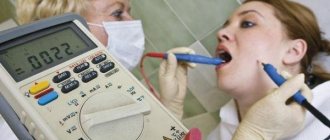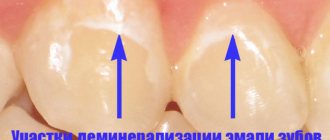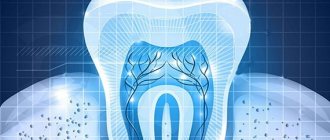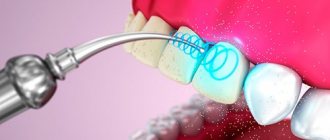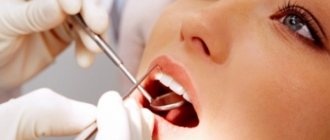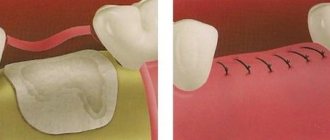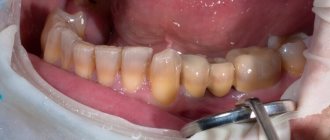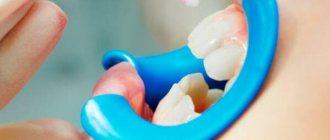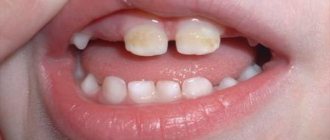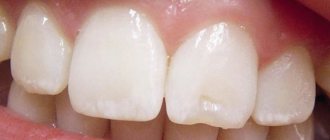Modern dental treatment
Dental treatment of teeth is a set of measures aimed at eliminating the inflammatory process and restoring chewing functions. The most common disease is, of course, caries and its complications. The timing of dental treatment directly depends on the stage of development of the disease. Thus, installing a dental crown or implanting several teeth will take different times, depending on the number of specialist appointments. It is worth noting that regular preventive examinations allow you to notice pathologies at an early stage, allowing for dental treatment without extraction and significantly simplifying it.
If a patient comes to the clinic with acute pain, the task becomes much more complicated. Therefore, every dentist will tell you that the best dental treatment is prevention.
Photos before and after dental treatment
Photos Before and After treatment of chewing teeth.
Photos Before and After treatment of front teeth.
Traditional recipes for caries
Decoctions of some herbs and plants can serve the purpose of caries prevention, provided that they are used regularly and do not exclude a visit to the dentist for an examination. So, experts recommend using the following medications:
- Decoction of onion peels. Two tablespoons of husk are poured into 100 ml of boiling water, this decoction is infused for half an hour and after cooling and filtering it should be rinsed in the mouth, both for preventive and medicinal purposes.
- Laundry soap. Cleaning is performed once a day and thanks to this procedure, harmful bacteria are destroyed, and a film is created that protects the teeth from their influence in the future.
- Milk. Replenishes calcium in the body and gives teeth protection from caries.
- Sage decoction. One tablespoon should be poured into 200 ml of boiling water and bring the broth to a boil. The broth should sit, then it should be strained and used for rinsing at least three times a day.
- A decoction of the calamus plant. For one glass of boiling water, take one spoon of herb, the resulting decoction is used for rinsing after hygiene procedures for oral care.
Endodontic dental treatment
What is endodontic dental treatment? This is a procedure aimed at treating root canals, usually using a microscope. If you ignore the symptoms of caries for a long time, pulpitis, periodontitis and other complications develop. Endodontic treatment of teeth under a microscope will help eliminate acute pain and relieve inflammation. The help of an endodontist is indispensable when there is a suspicion of a dental cyst or granuloma. Often, after canal treatment, complications arise due to poor quality treatment or stuck pieces of broken instruments. In such difficult cases, they also resort to endodontic treatment of the tooth canal under a microscope.
Treatment without drilling
Dental treatment without drilling involves the use of minimally invasive procedures. Some of them have been mentioned above. In particular, lasers are actively used to eliminate caries. This type of dental treatment is performed for adults and children. Among the main advantages is a reduced risk of any infection, since contact of equipment with organs and tissues of the oral cavity is eliminated.
Also, dental treatment without a drill can be performed using the chemical-mechanical method. A special preparation is applied to the area of the tooth affected by caries. It contains sodium hypochlorite and amino acids. Next, the specialist treats the affected area using special tools. Since only dead tissue is removed, the filling occupies a much smaller area, and it is also possible to preserve healthy areas as much as possible.
Another interesting technique was developed by German specialists. It is based on the bactericidal properties of ozone and is often used in pediatric dentistry. The gas used to treat teeth completely destroys microorganisms that cause caries.
The latest non-invasive methods
Before dental treatment, a specialist determines the degree of destruction of enamel, hard tooth tissue and dentin. In advanced cases, a granuloma forms around the root, which may subsequently increase in size. Modern methods of dental treatment make it possible to successfully combat the first signs of caries without the use of a drill. Among them:
- laser dental treatment;
- application of chemical-mechanical techniques;
- fluoridation – treatment of teeth with calcium;
- application of the air-kinetic method;
- ozone therapy.
How much calcium do we need and where to get it?
The average adult living in environmentally favorable (at least relatively) conditions needs to consume 500 mg of calcium per day. Boys and girls of puberty need to consume 1200-1300 mg of calcium per day. Approximately the same threshold should be maintained for all people under 24 years of age.
Women during pregnancy and active lactation need 1400-1500 mg of calcium per day. A similar amount of the element must be taken by women during postmenopause or premature menopause.
During these periods of life, women take special calcium supplements for bones and teeth.
Calcium reserves for teeth can be replenished by consuming the following food sources:
- Dairy and fermented milk products – natural yogurt, cheese, cottage cheese;
- Eggs (chicken and quail) - contain a sufficient amount of vitamin D, ensuring easy absorption of calcium;
- Fish and seafood (shrimp, mussels, squid) - contain fluorides and phosphorus.
In addition, we recommend that you include fresh hard vegetables and fruits (apples, carrots, cabbage, etc.) in your menu - they promote chewing intensity and stimulate salivation, performing mechanical sanitation of the oral cavity.
It is also important to eat fresh herbs and green leafy vegetables - their juices have antiseptic and mild bactericidal properties. Black and green tea contain fluorides, which absorb fluoride and strengthen dentin. Of course, we are talking only about natural leaf drinks, and not packaged surrogate.
Treatment of a tooth under a crown
After some time has passed after the installation of the prosthesis, subsidence of the gums and exposure of the neck of the tooth are often observed. All this contributes to the development of caries, and therefore pulpitis, periodontitis and other unpleasant diseases can appear even when the tooth is covered with a crown. Only a specialist can identify the problem and treat the tooth under the crown. If a disease is detected, the structure may need to be removed.
It is also the cause of problems - errors in the manufacture of the prosthesis: if the crown does not fit tightly around the neck of the tooth, bacteria can get under it. The specialist immediately removes such structures and carries out dental treatment. The crowns will subsequently be replaced, which will preserve the teeth and prevent the development of more serious diseases.
Charcoal for teeth whitening
The idea of using activated carbon to whiten teeth was borrowed by “traditional healers” from toothpaste recipes of the early twentieth century. Then wood ash was used as an abrasive element to clean enamel.
Today, the use of charcoal to lighten teeth leads to damage to the enamel and tooth sensitivity, and of course, no intended result in changing the color of teeth can be achieved.
Anesthesia
Conventional local anesthesia is performed very often today. Patients with increased sensitivity of soft tissues and children can first be given topical anesthesia. Also in dentistry, painkillers are used for dental treatment. The type of drug and its dosage are selected individually - it all depends on both the patient’s health condition and the clinical situation. For example, pediatric dentists often treat teeth with nitrogen. Laughing gas causes a feeling of mild euphoria and is not hazardous to health. The patient relaxes, and the doctor can calmly perform all the necessary manipulations. But general anesthesia in dentistry is used only in the most extreme cases.
Anesthesia after dental treatment can last up to 3 – 4 hours. Everything here is very individual and depends on how much anesthetic was used.
Carrying out the procedure at home
For electrophoresis, devices that generate continuous current are used.
They have two electrodes that are placed on the body. If there is a need for additional administration of the drug, then a gasket is impregnated with it, which is placed between the skin and the electrode. Preparations for this procedure must be in the form of a solution. Otherwise, their entry into the body will be impossible. The medicine breaks down into ions under the influence of current. They penetrate through the skin glands (sebaceous and sweat) into the patient’s body.
Electrodes that are placed on the human body have different charges. Which of them to place the gasket with the drug depends on the drug itself. Some are capable of being introduced from both the anode and cathode. But the same drugs are not administered from both poles at the same time. However, different substances may be delivered during the same procedure. This increases the benefits of the session and allows you to influence various organs and pathological processes.
Filter paper is used once. After the procedure is completed, it is disposed of. And electrophoresis pads do not change from one session to another. But when a medicine is administered, they are marked with the first letter with which the name of the drug begins. This allows the doctor to control the dosage and adjust prescriptions.
To carry out electrophoresis, a device that generates current is required. It could be:
- Elfor Prof;
- Elfor;
- Stream-1;
- Stream-2 and others.
The devices come with instructions in which everyone can read about how to assemble and turn on the device. The gaskets must have plus and minus marks. This indicates the polarity of the electrodes. It is taken into account when using medications.
Preparations for electrophoresis can be purchased at the pharmacy. You need to choose medications in the form of a solution or powder for its preparation. Storage of the diluted product is not intended - it must be done before each procedure.
Before performing electrophoresis at home, it is necessary to visit a doctor. He will prescribe the necessary medications and tell you which area to install electrodes on. Not in every case, pads are applied to the affected area. For example, for pain in the leg, the pelvic area is affected. This is due to the peculiarities of the innervation of the lower extremities.
Calcium electrophoresis is effective for both adults and children. It is used from a very early age. But when prescribing, one must take into account the presence of contraindications and the patient’s condition, so only a doctor can recommend it. Although the procedures themselves can be performed at home without losing effectiveness.
Features of treatment of anterior teeth
Treatment of anterior teeth is associated with some difficulties. A characteristic feature of the incisors is their smaller size compared to other teeth. The work that a dentist has to do is truly jewelry. Only an experienced specialist can achieve a high degree of aesthetics.
In the process of treating and restoring the shape of a diseased tooth, a filling can be performed using light-curing polymer materials or veneers. Their shade is selected taking into account the color of the enamel of the patient’s healthy teeth.
The last resort is the installation of crowns. This method is justified only if the tooth is severely damaged. Treatment of lower teeth in the frontal zone is performed using similar methods and techniques.
Reason to see a doctor: symptoms that cannot be ignored
If a tooth hurts, treatment should never be delayed. Any delay is fraught with serious problems not only for the oral cavity, but also for the whole body. The sooner the source of infection is identified, the easier and faster dental treatment can be performed in the clinic. Symptoms that indicate serious problems:
- acute throbbing pain in the tooth;
- significant increase in sensitivity;
- bad breath during regular hygiene;
- bleeding and swelling of the gums;
- tooth mobility;
- difficulty opening the mouth;
- the appearance of a defect on a tooth, an area with uneven edges and pigmentation.
Calcium gluconate for teeth
It is a very effective medicine that not only helps strengthen bones and teeth, but also has a whitening effect. This drug comes in tablets that must be crushed and dissolved in a liquid, preferably milk, and taken after each meal. The main benefits of calcium gluconate will be:
- the effectiveness of the fight against caries, and at all its stages;
- protection of tooth enamel from destruction;
- strengthening teeth with all necessary minerals and elements, including calcium and fluorine;
- long-lasting and effective whitening;
- high-quality oral hygiene.
There are other forms of release of this drug, for example, in the form of a gel rubbed in with cotton swabs. This option for using the medicine is characterized by the duration of its effect, the absence of allergic reactions and a positive effect on the condition of the teeth, in particular, thanks to the gel, the following occurs:
- decreased level of tooth sensitivity;
- destruction of plaque and tartar;
- increasing protection from various types of external influences;
- polishing tooth enamel;
- teeth whitening;
- elimination of microcracks in the row.
Stages of dental treatment
Despite the fact that modern methods involve virtually painless dental treatment, fillings and other procedures, many patients appear in the doctor’s office with acute pain and a whole “bouquet” of oral diseases. Treatment usually includes the following steps:
Diagnostics
A specialist examines the oral cavity, identifies problems and draws up a treatment plan. Additional examinations may be ordered. At the same stage, the doctor conducting the consultation discusses the cost of services with the patient and selects the most convenient time for an appointment.
Professional oral hygiene
It is advisable to begin dental treatment only after their surface is cleaned of hard and soft deposits.
Treatment
The process of treating caries involves removing the affected tissue. The procedure is performed using local anesthesia, and the treated area is isolated from the rest of the mouth. Rubber dam or cotton swabs can be used for these purposes.
Seals
Filling is carried out after cleaning the carious cavity. The final procedure is grinding the filling - this is necessary to eliminate the occurrence of discomfort during the process of chewing food.
Description of the enamel mineralization procedure
Before remineralization, foci of oral infections are sanitized and hard and soft bacterial plaque is necessarily eliminated.
Professional hygienic treatment is carried out using an ultrasonic and sandblasting machine, special paste and brushes. After preparation, the enamel is thoroughly dried. Applications or dental trays filled with gel are applied to the surface of the teeth to remineralize the teeth. The composition of medicinal preparations includes calcium, phosphorus, magnesium.
Stages of strengthening enamel with calcium gluconate:
- plaque removal;
- drying the enamel;
- applying applications with a 10% solution of calcium gluconate. The procedure is carried out for 15-20 minutes. Every 5 minutes, the turunda with medicinal liquid is changed;
- The final stage of enamel restoration is fluoridation. Manipulation is carried out using drugs containing sodium fluoride. Fluoridation helps protect teeth from external adverse environmental factors and reduce the likelihood of developing caries.
Manipulations are carried out daily or every other day. The course of treatment varies depending on the individual characteristics of the patient’s body and ranges from 10 to 20 procedures.
Why does a tooth hurt after treatment and what to do in this case?
Aching pain after treatment occurs quite often. However, its causes may be different, which means that the doctor’s actions to eliminate it are required different. Let's look at the most popular:
- Very often, after treatment, the tooth reacts to mechanical stress when chewing food. As a rule, minor pain appears after treatment of deep caries. This is due to the fact that the filling puts pressure on the pulp. Over time, the pain will pass.
- It is not uncommon for a tooth to ache after treatment and due to an individual reaction to the doctor’s intervention. The pain may persist for several days.
- Acute pain after dental treatment cannot be ignored. You must immediately contact a specialist. Unpleasant pain may indicate that there is inflammation after dental treatment.
- If you are sensitive to irritants such as hot and cold drinks, sweet or sour foods, then there is a high probability that the overhanging edge of the filling will injure the periodontal tissue in the gum area. This phenomenon leads to tissue inflammation and exposure of the tooth root, which is extremely sensitive to any irritants. Therefore, be sure to contact the dental clinic if your tooth aches after recent manipulations. The treatment was most likely carried out poorly.
Calcium norm for the body
But you shouldn’t force yourself to consume a lot of this microelement. For example, its excess in the body can negatively affect human health. If the daily dose is doubled, the following may occur:
- constipation will appear;
- flatulence;
- bloating;
- strong thirst;
- muscle spasms;
- formation of stones in the kidneys, urinary or gall bladder;
- the body’s natural absorption of elements such as zinc and iron is disrupted.
Foods with the highest calcium content
For children, the daily requirement is slightly different:
- for infants up to 6 months of age, it is enough to consume 400 mg of this element per day;
- from 6 months to 3 years - 600 mg;
- children from 3 years to 10 years should consume up to 800 mg per day;
- at the age of 11 to 18 years, the need for this microelement increases to 1200 mg per day.
Infants up to 6 months should receive all nutrients through mother's milk. But the older the baby is, the more nutrition he needs, and mother’s milk no longer meets his requirements.
Starting from 5–6 months, the first complementary foods are introduced into the infant’s diet. From this period, parents must control the intake of microelements into the baby’s body.
How much does dental treatment cost in Moscow?
Taking into account the fact that therapy involves an integrated approach, the total cost of dental services will consist of the costs of individual procedures. Approximate prices for dental treatment in Moscow are presented in the table below.
| Type of service | Price |
| Specialist consultation | from 500 rubles, but most often it is free |
| Professional hygiene of the entire oral cavity | from 3,000 rubles |
| Treatment of pulpitis (depending on the number of channels) | from 4,000 rubles |
| Filling using light-curing polymer material | from 3,000 rubles |
| Aesthetic restoration of anterior teeth | from 5,000 rubles |
Varnishes and gels for caries
As a solution, you can use gels and varnishes prescribed by the dentist, in particular, the already mentioned drug ICON. It is applied directly to the tooth enamel, has no color and immediately fills all the cavities on it. Then, after being illuminated by a lamp, this varnish hardens and becomes a reliable protection and barrier to pathogenic bacteria that cause caries. A significant disadvantage of this product is its high cost, around 5,000 thousand rubles.
The good thing about using gels to prevent caries is that you can do it on your own, without the involvement of specialists. They are applied to the teeth in a simple manner similar to regular toothpaste. Among such gels we can mention Fluocal, Elmex, Fluodent or Blend-a-med. It is not difficult to buy any of them; they are sold in almost every pharmacy.
